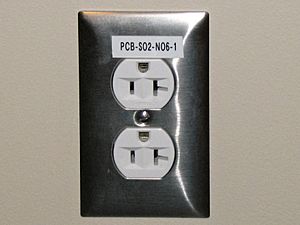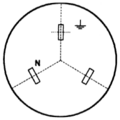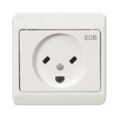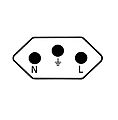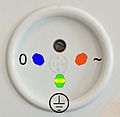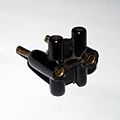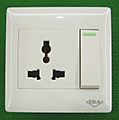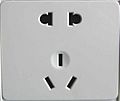Electrical outlet facts for kids
An electrical outlet (also called a receptacle or power point) is like a special socket in your wall. It lets you connect electrical devices, such as your phone charger or a lamp, to the electricity supply in your home. Most of the time, you'll find these outlets in walls, but sometimes they are in the floor. Occasionally, they are even in the ceiling for things like garage door openers.
Different countries often have different types of outlets and different voltages. This means a plug from one country might not fit or work in another. Luckily, you can often buy adapters to help convert between the different types.
Contents
What is an Electrical Outlet?
An electrical outlet is a key part of your home's electrical system. It's designed to safely deliver electricity to your devices. When you plug something in, the outlet creates a connection. This connection allows electricity to flow from the power lines into your device.
Outlets are built into the electrical wiring of a building. They are usually placed in convenient spots. This allows you to power lamps, computers, and other electronics.
Why are There Different Types?
You might notice that electrical outlets look different around the world. This is because different countries have their own standards. These standards developed over time for various reasons.
Different Voltages
One big difference is the voltage. Voltage is like the "pressure" of electricity. Some countries, like the United States, use around 120 volts. Others, like most of Europe, use around 230 volts. Devices are made to work with a specific voltage. Using the wrong voltage can damage a device or even be dangerous.
Different Plug Shapes
Another difference is the shape of the plugs and outlets. There are many different designs, like Type A, Type C, Type G, and so on. These shapes are designed to be safe and secure. They also help prevent you from plugging a device into the wrong voltage system. For example, a plug designed for 120 volts won't fit into a 230-volt outlet.
Safety Features
Many modern outlets have special safety features. Some have three holes instead of two. The third hole is for a "ground" wire. This wire provides an extra path for electricity to go if there's a problem. This helps protect you from electric shocks. Some outlets also have shutters that cover the holes. This prevents children from sticking objects into the outlet.
Using Adapters and Converters
If you travel to a different country, you might need an adapter or a converter.
- An adapter simply changes the shape of your plug. It lets your plug fit into a different type of outlet. It does not change the voltage.
- A converter (or transformer) changes the voltage. If your device is made for 120 volts and you are in a 230-volt country, you might need a converter. Always check your device's power requirements before plugging it in.
Safety Tips for Outlets
It's important to use electrical outlets safely.
- Never stick anything into an outlet except a proper plug.
- Don't overload an outlet by plugging in too many devices. This can cause overheating.
- If an outlet feels hot or smells strange, unplug everything and have an adult check it.
- Use surge protectors for valuable electronics. They protect devices from sudden spikes in electricity.
- Keep outlets away from water. Water and electricity are a dangerous mix.
Images for kids
See also
 In Spanish: Enchufe para niños
In Spanish: Enchufe para niños


